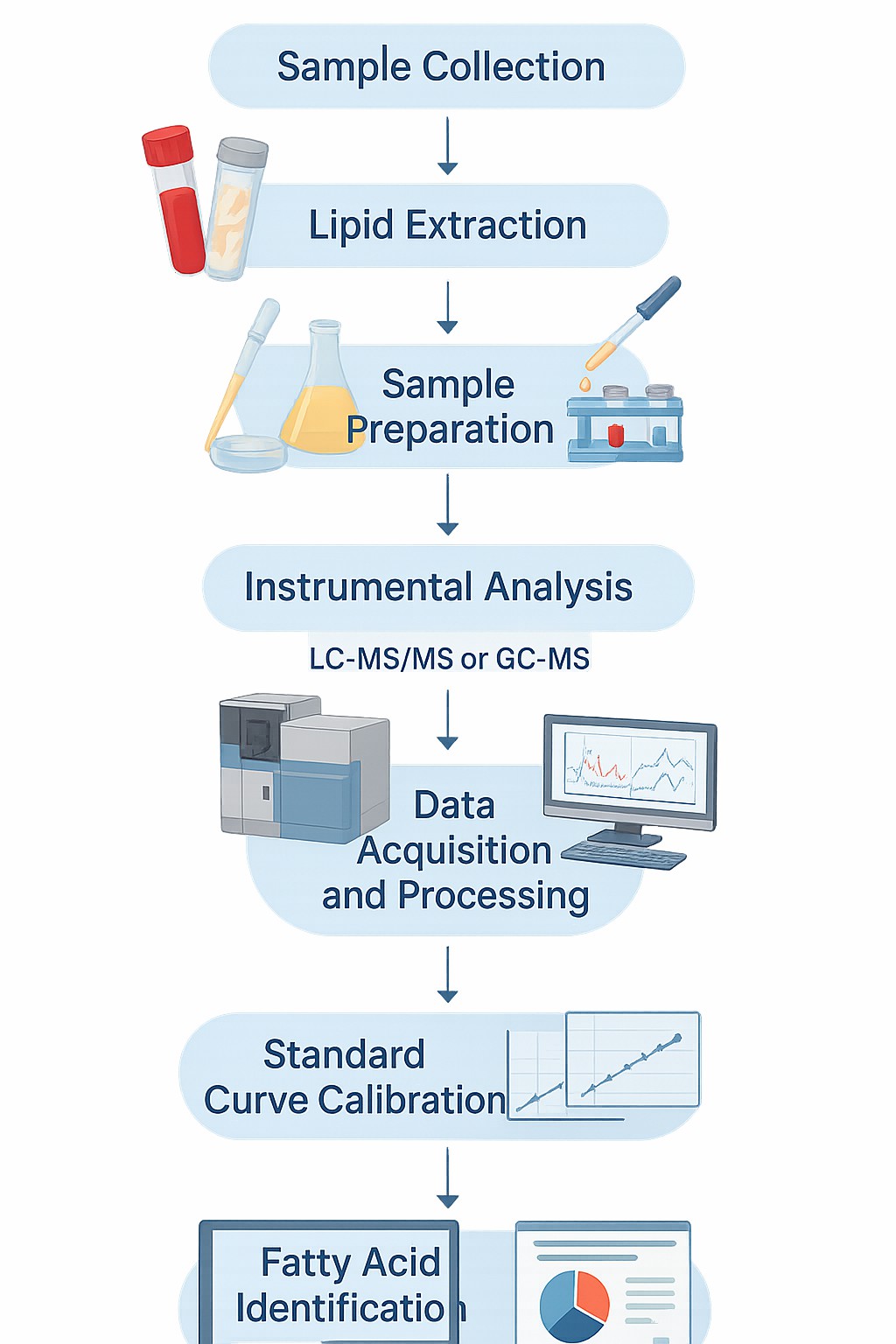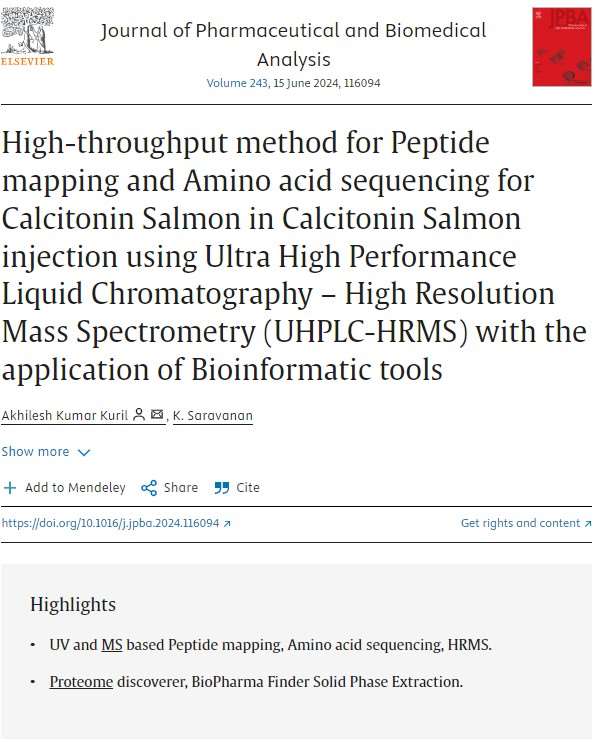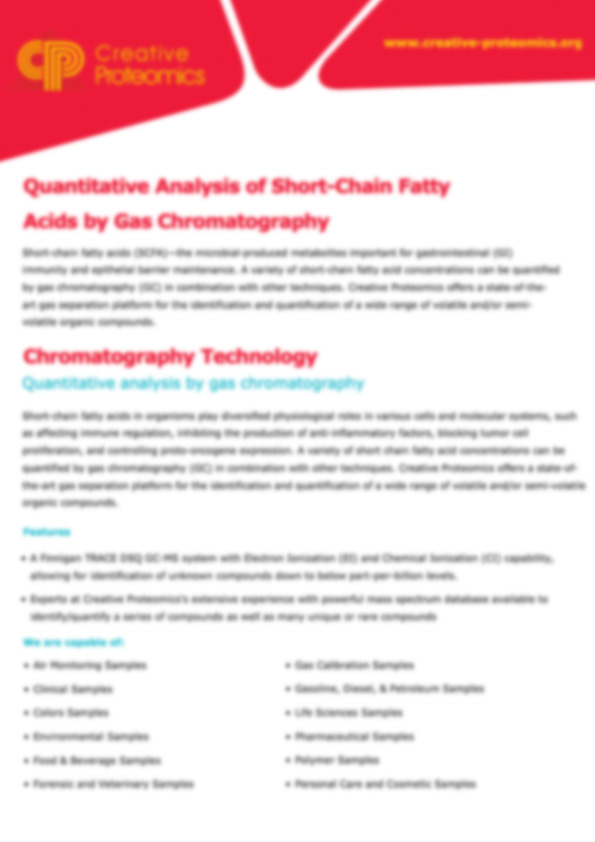Very Long Chain Fatty Acids Profiling Services for Accurate Quantification
Very long-chain fatty acids (VLCFAs) are fatty acids with carbon chains longer than 20 atoms. They serve as building blocks for key lipid mediators and cellular components like sphingolipids and glycerophospholipids. When genes that encode enzymes for VLCFA metabolism mutate, it can trigger inherited disorders including ichthyosis, muscle weakness, nerve damage, cognitive impairment, and vision loss. Precise profiling of VLCFAs is critical for understanding metabolic health, rare diseases, and drug development.
With advanced separation, identification, and quantification technologies, Creative Proteomics delivers dependable, cost-effective very long-chain fatty acids analysis services. We help researchers and developers achieve insights essential for understanding metabolic diseases, optimizing therapeutic strategies, and improving drug development workflows.
Submit Your Request Now
×- What is
- Our Approach
- Metabolist Coverage
- Platform
- Advantages
- Sample Requirement
- FAQs
- Publication
What Are Very Long-Chain Fatty Acids (VLCFAs)
Very long-chain fatty acids, often called VLCFAs, are a special group of fatty acids with carbon chains that are 20 or more atoms long. In the world of lipids, the length of the carbon chain changes how these molecules behave in living systems. Because of their size, VLCFAs don't just float around freely; instead, they become part of cell membranes or act as building blocks for bigger molecules like sphingolipids and glycerophospholipids.
These fatty acids help stabilize cell membranes, giving them the right flexibility and structure. Moreover, VLCFAs play roles in cell signaling, helping cells talk to each other and respond to changes in their environment.
Scientists also study VLCFAs because of their connection to certain genetic conditions and metabolic pathways. For instance, when the body can't break down VLCFAs properly, they can build up in tissues. Although we won't discuss diseases in detail here, this buildup makes VLCFAs important targets for biochemical research and laboratory testing.
Because VLCFAs are involved in so many critical biological functions, researchers in universities, research institutes, and pharmaceutical companies want to measure them accurately. Whether exploring basic biology or developing new drugs, scientists need precise information about these unique fatty acids.

Why Analyze Very Long-Chain Fatty Acids?
- Vital Role in Plant and Human Biology: All plant cells produce VLCFAs, which are essential for specialized metabolites in specific tissues. In plants like Arabidopsis thaliana, three core enzymes in the endoplasmic reticulum elongate fatty acids by adding two-carbon units at a time. The fourth enzyme, crucial for chain condensation, dictates the specific types and quantities of VLCFAs produced.
- Insight Into Genetic Disorders: In humans, disorders such as X-linked adrenoleukodystrophy (X-ALD) arise when VLCFAs accumulate in tissues. This happens because mutations in the ABCD1 gene disrupt the function of a key peroxisomal protein known as ALDP. Without ALDP, VLCFAs can't enter the peroxisome for proper breakdown, leading to damaging buildups in the spinal cord, adrenal glands, and brain white matter.
- Reliable Biomarkers: Elevated VLCFA levels in blood and tissues are critical biomarkers for diagnosing peroxisomal disorders like X-ALD. Although some VLCFAs come from the diet, most result from elongation of long-chain fatty acids in the body. Accurate measurement is essential for both research and clinical monitoring.
Challenges in Very Long-Chain Fatty Acids Profiling
Analyzing VLCFAs might seem easy, but several challenges make it quite complex.
Low Abundance:
- VLCFAs are often present in very small amounts in biological samples like blood or tissues.
- Detecting such low levels requires highly sensitive instruments.
Similar Structures:
- Many fatty acids look almost identical except for a couple of extra carbon atoms.
- It's hard to separate and identify each type accurately without advanced techniques.
Complex Biological Samples:
- Blood, tissues, or cells contain many other molecules besides VLCFAs.
- These other compounds can interfere with tests, causing false readings or mixed signals.
Need for Advanced Technology:
- Simple lab methods like basic chromatography aren't enough for VLCFA analysis.
- Scientists use GC-MS or LC-MS/MS to separate, detect, and measure VLCFAs precisely, even when levels are low.
At Creative Proteomics, we've solved these challenges with a robust GC-MS platform for reliable VLCFA analysis.
Our Approach to VLCFA Quantification
At Creative Proteomics, we know how tricky it is to measure VLCFAs. That's why we've developed a complete solution to help researchers get clear, reliable data for their projects.
Here's how we tackle VLCFA analysis:
Advanced Instruments:
- We use powerful machines like GC-MS (Gas Chromatography-Mass Spectrometry) and LC-MS/MS (Liquid Chromatography-Tandem Mass Spectrometry).
- These tools can separate and measure VLCFAs even when they're in very low amounts.
Custom Protocols:
- We've created special lab methods that improve how we extract and clean up samples.
- This helps remove other molecules that could interfere with the results.
High Sensitivity and Accuracy:
- Our technology can detect even tiny differences between similar fatty acids.
- This means researchers can trust the data for precise studies.
Strict Quality Control:
- Every test run goes through careful checks to make sure results are repeatable and correct.
- We use quality control samples to confirm that measurements stay consistent across projects.
Clear Reporting:
- Our reports include easy-to-read data tables, charts, and expert comments.
- Researchers can quickly understand the findings and plan their next steps.
Metabolist Coverage
| Very Long-chain Fatty Acids Quantified in This Service | ||
|---|---|---|
| Docosanoic Acid (C22:0) | Hexacosanoic Acid (C26:0) | Ratio C24/C22 |
| Ratio C26/C22 | Tetracosanoic acid (C24:0) | |
Workflow

Technology Spotlight: GC-MS and LC-MS/MS in VLCFA Profiling
When it comes to analyzing very long-chain fatty acids (VLCFAs), the right technology makes all the difference. At Creative Proteomics, we use two advanced tools: GC-MS and LC-MS/MS. Let's look at what these methods do and why they're so important.
GC-MS (Gas Chromatography-Mass Spectrometry)
How It Works:
- GC-MS first heats the sample so the fatty acids turn into gas.
- The gas travels through a special tube called a column, where the fatty acids separate based on size and how they interact with the column's coating.
- After separation, the molecules go into a mass spectrometer, which identifies them by measuring their mass.
Best For:
- Fatty acids that can handle heat and become gases.
- Getting very precise separation of molecules that look similar.
Benefits:
- Great for quantifying specific VLCFAs like C22:0 or C24:0.
- Produces clean, sharp peaks that help scientists spot tiny differences.
LC-MS/MS (Liquid Chromatography-Tandem Mass Spectrometry)
How It Works:
- LC-MS/MS starts with liquid chromatography, where the sample flows through a column under liquid conditions.
- Fatty acids separate based on how much they stick to the column's material.
- The separated molecules then enter a mass spectrometer for detection.
- The “tandem” part means it can break molecules into fragments and analyze them again for even more detail.
Best For:
- Fatty acids that can't handle heat or are tricky to analyze with GC.
- Studying VLCFAs in complex samples like blood plasma or tissue extracts.
Benefits:
- Detects low-abundance molecules that might be missed by other methods.
- Allows simultaneous analysis of many different fatty acids in a single run.
Both GC-MS and LC-MS/MS have their strengths. Depending on your samples and research goals, Creative Proteomics can recommend the best technique to deliver accurate, reliable VLCFA data.
Reporting and Data Deliverables
Detailed Quantification Results
- We show the amounts of each very long-chain fatty acid (VLCFA) measured in your samples.
- Results are reported in:
- μM (micromolar) for liquid samples like plasma.
- μg/mg (micrograms per milligram) for solid samples like tissues.
- We include important ratios such as:
- C24/C22
- C26/C22
These details help researchers see how VLCFAs change under different conditions or treatments.
Quality Metrics
- We report:
- Coefficient of Variation (CV): Usually below 10%, showing that results are reliable and repeatable.
- Calibration curves and internal standards used in your analysis.
- These metrics show the precision and trustworthiness of your data.
Visual Charts and Graphs
- Reports contain:
- Chromatograms showing how molecules separated during analysis.
- Bar charts or plots that make trends easy to spot.
- These visuals help you interpret results faster without digging through raw numbers.
Expert Comments
- Our scientists include notes and interpretations explaining what the numbers might mean for your research goals.
- We help connect VLCFA data to broader lipidomics studies or experimental questions.
Whether you're working in a research lab or supporting pharmaceutical development, good data reporting saves time and avoids confusion. Our reports give you not just numbers, but actionable insights for planning your next steps.
Why Choose Creative Proteomics for VLCFA Analysis?
Deep Expertise in Lipidomics
- We have years of experience working with all types of fatty acids, including the complex world of VLCFAs.
- Our scientists understand the tiny differences between fatty acid molecules and know how to measure them accurately.
Cutting-Edge Technology
- We use GC-MS and LC-MS/MS, two of the most powerful tools in lipidomics.
- These advanced instruments help us detect even low levels of VLCFAs, giving clients confidence in their data.
Custom Solutions
- Every project is different. We tailor our methods to fit your samples, research questions, and experimental goals.
- Whether you're exploring basic science or developing a new drug, we can adjust our workflows to meet your needs.
Quality and Consistency
- We follow strict quality control processes to ensure every result is accurate and repeatable.
- Our clients rely on us for consistent data they can trust across multiple studies.
Fast and Responsive Service
- We understand that time matters in research and development.
- Our team responds quickly to questions and works efficiently to deliver reports as soon as possible.
Clear Communication
- Our reports are easy to read, with clear charts, tables, and expert comments.
- We're always ready to explain results and help you understand how they fit into your bigger research picture.
Sample Requirements
| Sample type | Recommended sample size | Pre-treatment and storage |
|---|---|---|
| Tissue | 100-200 mg | Snap freezing in liquid nitrogen, stored at -80℃. |
| Urine | 200-500 μL | 5000×g 4℃ Centrifuge for 30-60min, remove supernatant, store at -80℃. |
| Serum/plasma | >100 μL | Collected serum/plasma, snap freezing in liquid nitrogen, stored at -80℃. |
| Cerebrospinal fluid, amniotic fluid, bile and other body fluids | >200 μL | 4℃ Centrifuge for 10min, (or filter using 0.22μm membrane), remove supernatant and store at -80℃. |
| Suspension cells | >1*107 | Centrifuge and collect cells after liquid nitrogen snap freezing and store at -80℃. |
| Walled cells | >1*107 | Cultured walled cells are stored in 1.5ml centrifuge tubes, snap freezing in liquid nitrogen and stored at -80℃. |
| Cell supernatant | >2 mL | centrifuge at 4℃ for 3 minutes, take the supernatant and store at -80℃. |
FAQs on VLCFA Analysis Services
What's the typical turnaround time?
Most projects take a few weeks from the time we receive your samples.
Exact timelines depend on:
- The number of samples
- The complexity of the analysis
We'll always give you an estimated timeline when you start your project.
Can you analyze VLCFAs in different sample types?
Yes! We can work with:
- Plasma or serum
- Tissues (like liver, brain, or plant samples)
- Cell cultures
- Other biological materials
Let us know your sample type, and we'll advise on the best approach.
How will my data be reported?
Your report will include:
- Amounts of each VLCFA (e.g. μM or μg/mg)
- Quality metrics like CV values
- Graphs and charts for easy understanding
- Expert comments explaining what the results might mean for your research
Is the data suitable for regulatory submission?
Yes. Our methods follow strict quality standards and produce data suitable for:
- Research publications
- Regulatory documentation
- Internal decision-making for R&D
Can your team help interpret the results?
Absolutely! We don't just send you numbers.
Our scientists:
- Explain what your data shows
- Help connect VLCFA results to your research questions
- Suggest next steps if needed
Learn about other Q&A about proteomics technology.
Publication
Here are some publications in Fatty Acids research from our clients:

- Proteolytic activation of fatty acid synthase signals pan-stress resolution. Nature Metabolism. https://doi.org/10.1038/s42255-023-00939-z
- B cell-intrinsic epigenetic modulation of antibody responses by dietary fiber-derived short-chain fatty acids. Nature Communications. https://doi.org/10.1038/s41467-019-13603-6
- Prospective randomized, double-blind, placebo-controlled study of a standardized oral pomegranate extract on the gut microbiome and short-chain fatty acids. Foods. https://doi.org/10.3390/foods13010015
- Fatty Acid and Antioxidant Profile of Eggs from Pasture-Raised Hens Fed a Corn- and Soy-Free Diet and Supplemented with Grass-Fed Beef Suet and Liver. Foods. https://doi.org/10.3390/foods11213404














